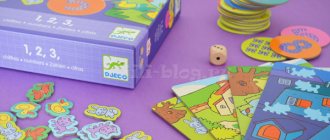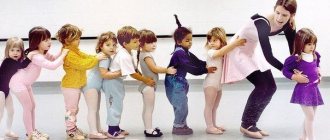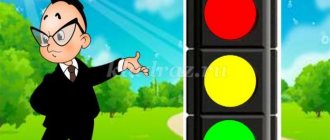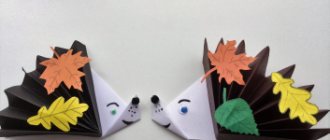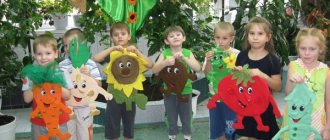Progress of the game
The teacher puts red balls into a plate and says: look, children, I have red cherries in my plate. I’ll take a spoon and fill it with cherries and feed the doll. Feeding the doll. This is how Mashenka eats cherries well. Did you eat it? I’ll put the bone in a glass.
Children, let's feed all the dolls with cherries (children feed the dolls)
.
Card#2
Didactic game "Lacing"
Goal: development of coordination of small hand movements and visual control.
Material: cardboard card (can be shaped like a shoe, a jar, etc.)
with holes and lace.
Progress of the game
Children, let's collect beautiful flowers on this table. You have circles of different colors lying next to you. You need to find a circle of the desired color and insert it into the flower. When each of you collects your flower, we will make a bouquet and show it to the doll. (The teacher asks the children what color their flowers are, the middle).
Card#4
Didactic game “Clothes pegs in a basket”
Goal: develop fine motor skills of the fingers; develop the ability to remove and put on clothespins.
Material: small clothespins, basket (with thin handle)
.
Didactic games and teaching aids
“Match the lid to the box”
Goal: selection of items according to the sample.
Didactic material: boxes of different shapes (round, quadrangular, rectangular, triangular) and corresponding lids.
Methodological techniques: the teacher, holding the child’s hand, traces the shape of the box’s opening with his finger. Then he shows the object, accompanying the action with a word. In front of the children, he lowers the object into the corresponding hole. After that, he offers the children this task.
"Funny Clothespins"
Goal: to teach children to correctly take and open a clothespin, find its location by color.
Didactic material: a transparent container with colored stripes glued along the edge, a set of colored clothespins
Game “Name the properties of materials”
Goal: To learn to determine the names of various properties of a material, to establish relationships between the material and its sensation. Demonstration material for the game: samples of materials that feel different to the touch, sewn into squares of fabric that feels different to the touch. Let each child play with the squares and feel them. Talk with children about the different properties of materials: are they hard or soft, smooth or rough... When children remember their tactile sensations of different types of surfaces, mix up the squares and give each child one sample. Will they be able to find a match for this sample? Of course, children will be able to navigate not only with the help of tactile sensations, but also with the help of vision. But at the initial stage this will not hurt, as children will be able to gain confidence in their abilities. Then you can complicate the task. Let the children try to pick “doubles” blindly. In this case, they will navigate based entirely on tactile perception. When giving this task, ask the children to name the properties of materials: hard, soft, smooth, rough.
Didactic sensory game “Guess what’s making noise”
Sensory development (sensation, feeling) is aimed at the development of visual, auditory, tactile, kinetic and other types of sensations and perceptions. The diversity of his environment is of decisive importance in the cognitive development of a child. The child should be surrounded by toys made of different materials that move. Also toys that use different principles of sound production; homemade noisy, rattling, rustling objects . I present to your attention the game “ Noise Makers ”.
Didactic game “Magic shoes”, “Cheerful hedgehog”
Purpose of the game : To develop fine motor skills and teach the child to lace up shoes, insert them into their holes, and correctly fasten and unfasten buttons.
Objectives : To cultivate perseverance and determination; develop speech activity and attention; promote the development of logical thinking.
"Sponge stamps"
All-round creative development is useful and necessary for all children. But not all children like to draw , but the technique of drawing with stamps is liked by all children and even adults without exception. By drawing in this way, children are not afraid of making mistakes, since everything can be easily corrected, and something new can easily be invented from a mistake, and the child gains self-confidence, overcomes the “fear of a blank sheet of paper” and begins to feel like a little artist. He develops an INTEREST, and at the same time a DESIRE to draw . After all, you can print with anything. This is what real creativity will be.
In order for printing figures to acquire some meaning, invite your child to decorate a paper plate, a vase cut out of cardboard, or a painted doll’s . You can draw rowan berries and scarlet strawberries with foam rubber, beads on the girl’s neck and a bright rooster’s tail. The main thing is that the creative process is enjoyable and evokes an emotional response in the young artist.
Do-it-yourself non-standard equipment for physical education classes in kindergarten made from waste material
Making non-standard equipment from waste material with your own hands for physical education and using it in classes and games Goal: To create interest in non-standard equipment, to involve teachers and parents in its production; develop creativity and imagination when using non-standard equipment; motivate children to be physically active through the use of non-standard equipment in independent activities.
Body massagers. Kinder massagers
Objectives: Strengthen the muscles of the back, chest and legs
"Basketball basket"
Goal: Throw the ball into the hoop. Develops dexterity and accuracy. The difficulty of the exercise is adjusted by the distance from the ring.
Organization: The bottom and top of a plastic bottle (5 l) are cut off. The edges of the bottle are tied with polypropylene thread
Use case: Who will score more points for each hit.
Busyboard - an entertaining educational board for children
A busy board (or development board) is a special invention of modern educators that allows you to achieve two goals at once: to reliably distract a child’s attention so that he does not engage in various stupid things, and at the same time develop his intelligence through play.\
Didactic game “Carnations and Rubber Bands”
This game is aimed at developing fine motor skills in the hands of children of primary preschool age, developing sensory perception, thinking and imagination.
"Development board"
Didactic game " Aquarium ".
The game is designed for children of middle and senior preschool age.
Purpose of the game: Continue to develop the ability to count to 10, using the correct counting techniques: name the numbers in order; relate each numeral to only one object of the group being counted, form ideas about ordinal counting, introduce decorative fish and sea creatures, develop children’s motor skills and sensory skills.
«Experimentation corner."
Labeled containers contain items for testing and experimentation , and can also be used for creativity. They contained: sand, earth, pebbles, river pebbles, tree bark, twigs, mosses, tree seeds, flower and vegetable seeds, balls, pieces of fur, fabric, leather, wire, acorns, cones, chestnuts, shells, balloons ... Several coniferous branches from pine, spruce, thuja, juniper. I sewed several aprons and arm ruffles.
“Theater of a healthy lifestyle” (our assistants are washbasins, toothpickers,
Progress of the game
A bunny comes in. Children, look, a bunny came to us and brought something with him. Children looking at the basket
with clothespins. The teacher says: the bunny wants to play with you. And shows actions with clothespins. Children try to put clothespins on and off a basket. After this, the gameplay takes place. One clothespin is put on by the child, the other by the teacher (in the role of a bunny)
. And they film it the same way.
Card#5
Didactic game “Let’s assemble a pyramid”
Goal: to train children in the ability to assemble a pyramid: remove and string rings. Teach children to find objects of the same size by placing one object on top of another.
Material: five ring pyramids
Progress of the game
The teacher shows the template. Look, children, there are holes around the edges and a string is tied. Today we will embroider. I thread a lace into each hole: first on one side, then on the other. Look how smooth the path turned out. Now, you guys try it. As a complication, suggest cross stitching.
Card#3
Didactic game “Collect a flower”
Goal: to consolidate knowledge of primary colors, improve the skill of finding the right one among circles of different colors and inserting it into the middle of the flower; develop fine motor skills of fingers.
Material: flowers of red, blue, yellow, green with a cut out middle and circles for them.
